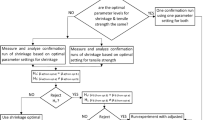Abstract
An automotive triangle trim was chosen as a research model, and the influence of processing parameters was determined with the Taguchi experimental method. An L27 (313) orthogonal array was constructed to investigate the significance of each factor (mold temperature, melt temperature, injection time, V/P switchover, packing pressure, and packing time). The computer-aided engineering software Moldflow was employed to determine the extent of warpage. The influence of processing parameters was analyzed by obtaining the signal- to-noise ratio and by conducting a range analysis. Furthermore, the processing parameters for minimizing warpage were optimized. Subsequently, the optimization packing condition for warpage minimization based on the filling conditions.
Similar content being viewed by others
References
B. Farshi, S. Gheshmi and E. Miandoabchi, Optimization of injection molding process parameters using sequential simplex algorithm, Materials and Design, 32 (2011) 414–423.
W.-L. Chen, C.-Y. Huang and C.-W. Hung, Optimization of plastic injection molding process by dual response surface method with non-linear programming, International Journal for Computer-Aided Engineering and Software, 27 (2009) 951–996.
H. Kurtaran, B. Ozcelik and T. Erzurumlu, Warpage optimization of a bus ceiling lamp base using neural network model and genetic algorithm, J. Mater. Process. Technol., (169) (2005) 314–319.
S. Kitayama, R. Onuki and K. Yamazaki, Warpage reduction with variable pressure profile in plastic injection molding via sequential approximate optimization, International Journal of Advanced Manufacturing Technology, 72 (5-8) (2014) 827–838.
M. T. Chuang and Y. K. Yang, Simulation study on optimization of injection molding process for thin-shell plastic parts via the taguchi method and grey relational analysis, International Polymer Processing, 24 (1) (2009) 51–58.
T. Erzurumlu and B. Ozcelik, Minimization of warpage and sink index in injection-molded thermoplastic parts using Taguchi optimization method, Materials and Design, 27 (10) (2006) 853–861.
B. Ozcelik and I. Sonat, Warpage and structural analysis of thin shell plastic in the plastic injection molding, Materials and Design, 30 (2009) 367–375.
W. Guo, L. Hua and H. Mao, Minimization of sink mark depth in injection-molded thermoplastic through design of experiments and genetic algorithm, International Journal of Advanced Manufacturing Technology, 72 (1-4) (2014) 365–375.
W. Guo, L. Hua, H. Mao and Z. Meng, Prediction of warpage in plastic injection molding based on design of experiments, Journal of Mechanical Science and Technology, 26 (4) (2012) 1133–1139.
D.-G. Ahn, D.-W. Kim and Y.-U. Yoon, Optimal injection molding conditions considering the core shift for a plastic battery case with thin and deep walls, Journal of Mechanical Science and Technology, 24 (2010) 145–148.
J. H. Cho, M. K. Lee, S.-M. Park, S. Hong and N. Kim, Prediction of thermal deformation considering the residual stresses for the PMMA-TSP laminated structure, Journal of Mechanical Science and Technology, 25 (2011) 3135–3140.
P. NguyenThi, A. Kwon, Y.-E. Yoo and J. S. Yoon, Model study on flow behavior for investigating coating conditions in the in-mold coating process, Journal of Mechanical Science and Technology, 27 (2013) 2967–2971.
Author information
Authors and Affiliations
Corresponding author
Additional information
Recommended by Editor Chongdu Cho
Wei Guo received his Ph.D. degree in Materials Processing Engineering from the Wuhan University of Technology, China, in 2013. He is currently a teacher at the School of Materials Science and Engineering at Wuhan University of Technology in Wuhan, China. Dr. Guo’s research interests include Advanced Technology for Automotive Components.
Rights and permissions
About this article
Cite this article
Zheng, G., Guo, W., Wang, Q. et al. Influence of processing parameters on warpage according to the Taguchi experiment. J Mech Sci Technol 29, 4153–4158 (2015). https://doi.org/10.1007/s12206-015-0909-0
Received:
Revised:
Accepted:
Published:
Issue Date:
DOI: https://doi.org/10.1007/s12206-015-0909-0



